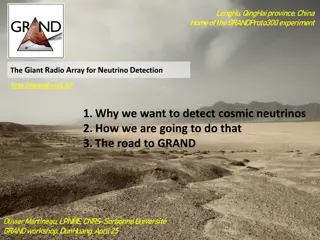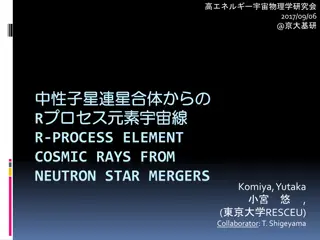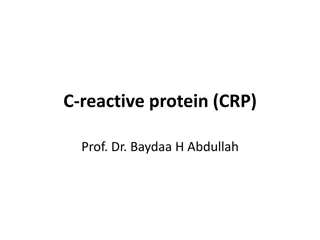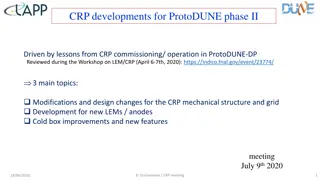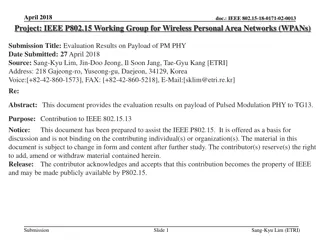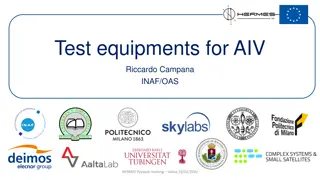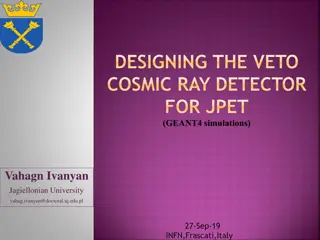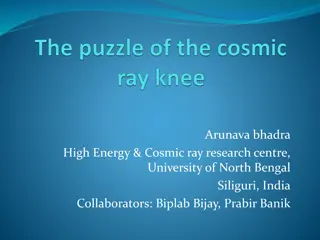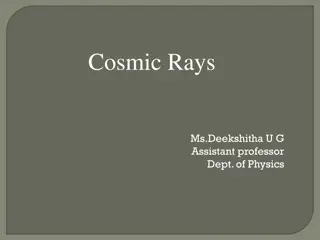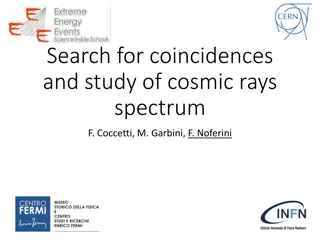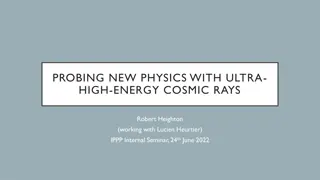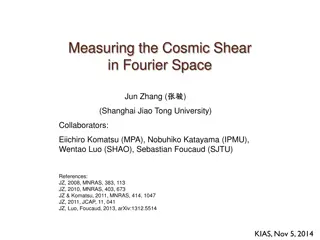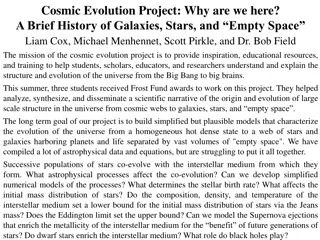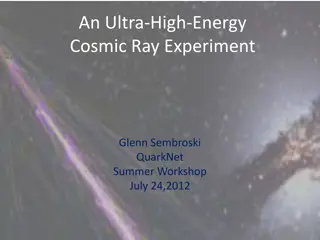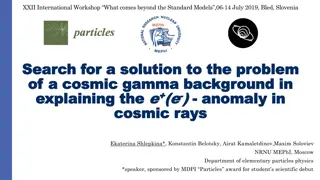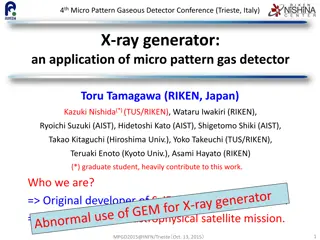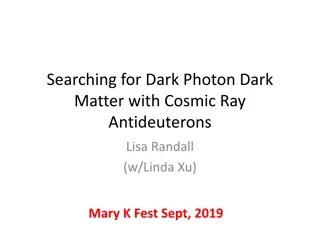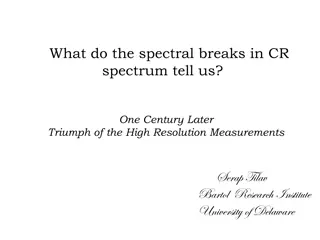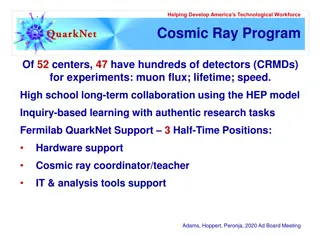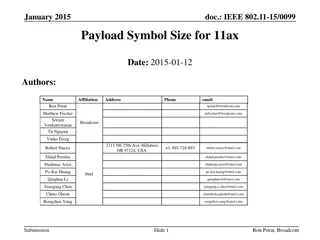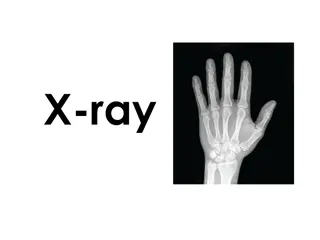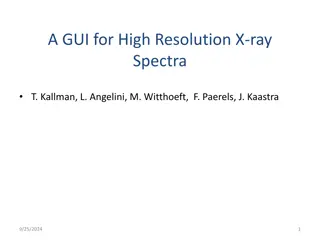EagleSat.2 Cosmic Ray Payload (CRP) Overview
EagleSat.2 is a space mission designed to detect incoming cosmic ray particles and determine their direction and magnitude. The mission utilizes CMOS sensors and tungsten layers to capture data and estimate energy loss. Operational logistics include cycling sensors per orbit to manage power and data constraints. A high-altitude balloon test provided proof of concept data, although inconclusive.
Download Presentation

Please find below an Image/Link to download the presentation.
The content on the website is provided AS IS for your information and personal use only. It may not be sold, licensed, or shared on other websites without obtaining consent from the author. Download presentation by click this link. If you encounter any issues during the download, it is possible that the publisher has removed the file from their server.
E N D
Presentation Transcript
EagleSat 2: Cosmic Ray Payload (CRP) Overview and Developments April 13, 2019 by Jason Hamburger 1
Outline Mission Overview Sensor Operation Logistics Preliminary Testing 2
CRP Mission Overview Objective to detect incoming cosmic ray particles and determine their direction and magnitude. Types of Cosmic Rays: Anomalous Energy Levels: 10 to 10 eV Origin: Ionized interstellar atoms Galactic Energy Levels: 10 to 10 eV Origin: Shocks of supernovas Solar: Energy Levels: 10 to 10 eV Origin: Corona of the Sun Fig CRP-1: Cosmic Ray Sources (https://photojournal.jpl.nasa.gov/jpeg/PIA16938.jpg) 3
CRP Mission Concept (1 of 2) Two layers of CMOS sensors to detect direction Use straight line approximation and the known height between the two sensors Local direction angle calculated relative to the pixel array GPS and attitude data recorded for specific location of test Cosmic Ray Path CMOS Pixel Array 1 CMOS Pixel Array 2 Fig CRP-3: Pixel Arrangement 4
CRP Mission Concept (2 of 2) An array of four CMOS sensors per layer Two sensors have tungsten over the sensor pixel array Two sensors have no tungsten and are directional Determine magnitude from pixel intensity before and after tungsten Estimate the energy loss through the tungsten to aid in calculation Directional used to compare intensity values and showering effect Top View (0.25 cm) Side View Cosmic Ray Path 1 Cosmic Ray Path 2 Sensor Array Layer 1 (0.5 cm) Tungsten (0.5cm) Tungsten (0.25cm) Sensor Array Layer 2 Fig CRP-4: Sensor Arrangement Side & Top Views 5
CRP Sensor Operation Logistics 2-5 cycles per orbit depending on: Current power levels Current data amount (Data cap ~8 kilobytes per orbit) Run 2 sensors at a time Alternate to new pair of sensors 5-10 second cycle time Expecting 1 particle per square meter per second 6
CRP PiCAM Balloon Test Data High Altitude Balloon Test Environment with sensor behind metal, battery, and foam 4 hr. flight 3 Suspect interactions Non-streaked (2x2) ~0.0758 nm2 103 Intensity (Medium) Proof of concept, but inconclusive data Fig CRP-17: Sample Detection 7
CRP UCAM-III Test 1 Gamma Rays with no lead plating 2 hr. 31 Interactions Non-Streaked (1x1) 108 Max Intensity Fig CRP-18: Test 1 Detections 8
CRP UCAM-III Test 2 Gamma Rays with lead plating 2 hr. 10 Interactions Non-Streaks (2x2) 74 Max Intensity Fig CRP-19: Test 2 Detections 9
CRP UCAM-III Test 3 Alpha Particles with no lead plating 0 Interactions Alpha Particle source was too depleted (10.5 half lives) 10
CRP UCAM-III Test 4 Gamma Rays with Sensor tilted, no lead plating 2 hr. 9 Interactions More particle streaking 66 Max Intensity Fig CRP-20: Test 4 Detections 11
Questions? Jason Hamburger hamburj1@my.erau.edu 12
CRP Terms and Definitions Hit: Cosmic Ray crossing both sensors pixel arrays with a magnitude greater than the background noise Interaction: Cosmic Ray crossing only one sensor s pixel array with a magnitude greater than the background noise Sensor Capture Time: Exposure time length between sensor activation and deactivation Magnitude: Pixel Intensity Value 14
CRP Detecting Cosmic Rays Cloud chambers Ground based More for demonstrations Geiger counters Insufficient data (only flux, no magnitude or direction) Scintillator Detectors Good for magnitude, but not as much for direction Harder to interface with CCD chips Generally more expensive CMOS chips Determine cosmic ray characteristics through image processing of the pixels Chosen design method Fig CRP-2: Cosmic Ray Detection (https://www.cloudynights.com/articles/cat/articles/capturing-cosmic-rays-with-a-digital-camera-r3046) 15
CRP Hardware Selection Arducam 14Mp CMOS (MT9F002) Mass: ~30 g Max Power: 0.443 W Dimensions: 4.0 cm x 4.0 cm x 0.45 cm (x,y,z) Pixel Size: 1.4 m x 1.4 m (x,y) Operational Temperature Range: -30 C to 70 C Easy to Interface Fig CRP-5: Arducam (http://www.arducam.com/products/camera-breakout-board/14mp-mt9f002/mt9f002-m12/) 16
CRP Direction Image Processing Fig CRP-13: Direction Image Processing Block Diagram 17
CRP Magnitude Image Processing Fig CRP-14: Magnitude Image Processing Block Diagram 18
CRP Testing Hardware Raspberry Pi Camera Module (PiCAM) Mass: ~3 g Dimensions: 2.5 cm x 2.4 cm x 0.9 cm (x,y,z) Pixel Size: 1.4 m x 1.4 m (x,y) Resolution: 8 Megapixels Fig CRP-15: Raspberry Pi Camera (https://uk.pi-supply.com/products/raspberry-pi-camera-board-v1-3-5mp-1080p) 19
CRP Testing Hardware uCAM-III Mass: ~15 g Dimensions: 3.2 cm x 3.2 cm x 1.4 cm (x,y,z) Pixel Size: 5.55 m x 5.55 m (x,y) Resolution: 300 K pixels Fig CRP-16: uCAM-III (https://www.gotronic.fr/art-mini-camera-ucam-iii-27148.htm) 20
CRP Programming Block Diagram Fig CRP-6: Programming Block Diagram 21
CRP Interface Design Fig CRP-7: Interface Design Block Diagram 22
CRP Interface Design (MUXes) Fig CRP-8: Interface Design MUXes 23
CRP Cycle Definition (Phase 1) Fig CRP-9: Cycle Definition Block Diagram 24
CRP Cycle Definition (Phase 2) Fig CRP-10: Cycle Definition Block Diagram 25
CRP Cycle Definition (Phase 3) Fig CRP-11: Cycle Definition Block Diagram 26
CRP Cycle Definition (Phase 4) Fig CRP-12: Cycle Definition Block Diagram 27
CRP Expected Data Products Number of interactions with the sensors Orbit location of interactions Direction of interactions Magnitude of interactions 28
CRP Transmitted Data GPS and attitude data from all interactions Pixel indices from all interactions Pixel magnitude data from all interactions Pixel intensity values (Pixels have intensity values from 0-255. We look at BGNN < # < 255 to help determine magnitude, where BGNN stands for Back-Ground Noise Number. BGNN varies, but from preliminary tests we have been primarily using 120.) Time of the interactions 29
CRP Sensor Trade Study Adafruit TSL2591 High Dynamic Range Digital Light Sensor TTL Serial JPEG Camera with NTSC Video Arducam (CMOS MT9F002) (Mini?) IC IMAGE SENSOR LUPA300 48LLC Rank Criteria Weight % RB-Spa-1132 uCam-III 1.96 47 17.64 30.8 31.36 98 Pixel Size ( m2) 30% 5 1 2 1 1 1 Pre-Populated Board Pre-Populated Board Pre-Populated Board Pre-Populated Board Pre-Populated Board No Board Development Viability 25% 5 5 5 5 5 1 0.297 0.167 < 0.1 0.1 0.096 0.2961 Detection Area (cm2) 20% 2 2 1 2 1 2 0.724 0.6 0.1235 0.375 0.375 0.19 Power (W) 15% 2 2 5 3 3 5 7.2 3.072 0.304 4.096 6.5 0.25589601 Volume (cm3) 10% 2 3 5 3 2 5 TOTAL 100% 3.65 2.55 3.3 2.7 2.4 2.2 30


